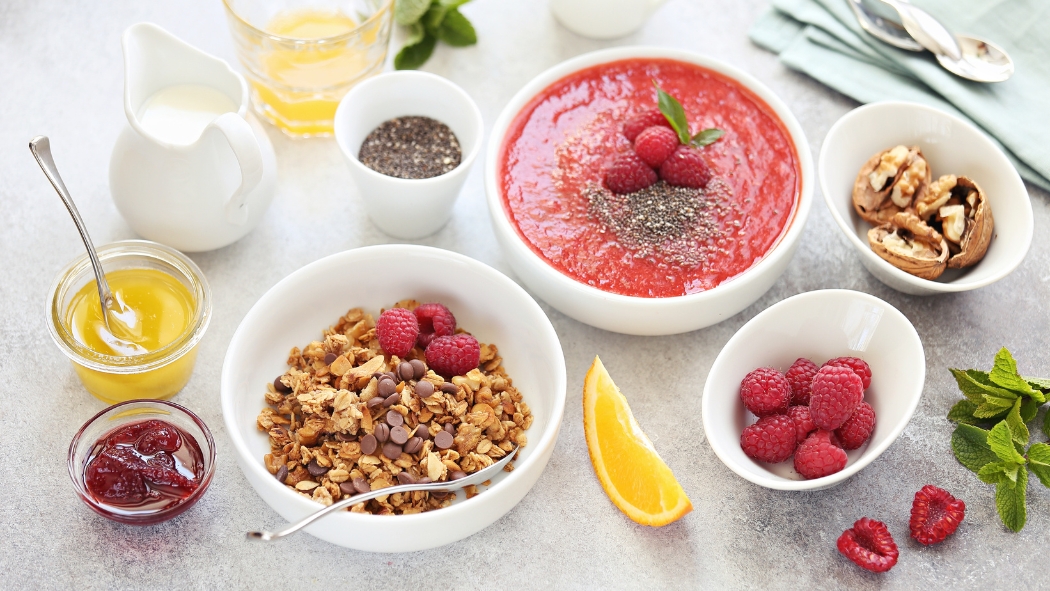The first time I really thought about my gut, it wasn’t pretty. I’d been on a junk food bender that would make a college student blush (think late-night pizza, questionable gas station snacks… the works). My stomach felt like a grumpy, rumbling monster. And, let’s be real, it was pretty monstrous. That’s when I realized I needed a gut-friendly lifestyle overhaul. Not just a diet, but a whole new way of thinking about what I put in my body. Why does your gut seem to control your whole life sometimes?
This isn’t going to be one of those preachy, “eat-your-broccoli-and-be-happy” articles. I’m a firm believer in enjoying life (and sometimes, that means a slice of pizza). But I’ve also learned that a happy gut equals a happy me. And it probably equals a happy you, too. So, let’s dive into how to make that happen, shall we?
Step 1: Fiber is Your Friend (Seriously, Don’t Be Scared)

Okay, “fiber” doesn’t exactly sound exciting. It sounds like something your grandma recommends. But trust me on this one. Dietary fiber is the unsung hero of gut health. It’s like the fuel that keeps your good gut bacteria thriving. These little guys, and gals, are crucial. In fact, we have around 160 different species of bacteria in our guts, and they weigh as much as 2 kilograms! Crazy.
Fiber helps you… well, go. It keeps things moving smoothly, preventing that awful bloated, constipated feeling. Plus, when your gut bacteria break down fiber, they create these amazing things called short-chain fatty acids (SCFAs). These SCFAs are like little superheroes for your gut lining.
There are two main types of fiber: soluble and insoluble. Soluble fiber (think oats, beans, the good stuff in citrus fruits) turns into a gel-like substance. It’s like a cozy blanket for your insides, and it helps with blood sugar and cholesterol. Insoluble fiber (nuts, cauliflower, green beans) is the roughage – it adds bulk and keeps things moving.
My go-to? Raspberries (8g of fiber per cup!), artichokes (a whopping 10g!), and good ol’ apples (with the skin on, please!). Aim for that “eat the rainbow” thing – lots of colorful fruits and veggies. In Australia, they recommend at least 25 grams of fiber a day for women and 30 grams for men. You got this.
Here’s a little cheat sheet (with clarification on raw vs. cooked):
| Fruit/Vegetable | Fiber Content (approximate per serving) | Notes |
| Raspberries | 8 grams per cup (raw) | |
| Artichokes (medium) | 10 grams (cooked) | |
| Guava (1 cup) | 9 grams (raw) | |
| Persimmon (1) | 6 grams (raw) | |
| Mango (1) | 5 grams (raw) | |
| Pear (medium) | 5.5 grams (raw) | With skin |
| Apple (medium, with skin) | 4.4-4.5 grams (raw) | |
| Collard greens (1 cup) | 4 grams (cooked) | |
| Swiss chard (1 cup) | 4 grams (cooked) | |
| Sweetcorn (1 cup) | 4 grams (boiled) | |
| Potato (medium, with skin) | 4 grams (baked) | |
| Brussels sprouts (1 cup) | 3.7-4.5 grams (boiled) | |
| Carrots (1 cup) | 3.6 grams (raw) | |
| Green peas (1 cup) | 6.5-9 grams (cooked) | |
| Broccoli (1 cup) | 2.4 grams (raw); ~5g (cooked) | Big difference! |
| Beets (1 cup) | 3.8 grams (raw) | |
| Banana (medium) | 3.1 grams (raw) | |
| Strawberries (1 cup) | 3 grams (raw) | |
| Orange (medium) | 3 grams (raw) |
Step 2: Plant Power! (Variety is the Spice of Life…and Gut Health)

This is where things get fun. Think of your gut microbiome as a bustling city. You want a diverse population of bacteria, not just a monoculture. That means eating a wide variety of plant-based foods.
The magic number? Try to aim for at least 30 different types of plants per week. Sounds daunting? It’s not, I promise! Think beyond just your usual salad. Throw some lentils into your soup, add some nuts and seeds to your yogurt, snack on some berries. Get creative!
Why is this important? Because different plants have different types of fiber and these cool things called polyphenols. These feed different types of bacteria. It’s like throwing a party for your gut and inviting everyone. And don’t forget prebiotics! These are like the food for your probiotics. Think garlic, onions, asparagus – they’re like the fertilizer for your gut garden.
Step 3: Fermented Foods: Your Gut’s New BFFs

Okay, this is where I get really excited. Fermented foods are like a probiotic powerhouse. They’re packed with live, beneficial bacteria that can help balance your gut microbiome.
My personal favorites? Yogurt (plain, unsweetened – check for “live and active cultures”), kefir (it’s like a drinkable yogurt, but even more probiotic-y), and kimchi (spicy fermented cabbage – don’t knock it ’til you try it!).
Here’s a peek at some fermented friends and their superpowers:
| Fermented Food | Common Beneficial Bacteria | Specific Gut Health Benefits |
| Kefir | Lactobacillus kefiri, various yeast and lactic acid bacteria | May manage blood sugar, boost digestive health |
| Kimchi | Lactobacilli, various bacteria | Lower cholesterol, reduce insulin resistance |
| Sauerkraut | Lactobacilli, Leuconostoc, Pediococcus | Source of live cultures (if unpasteurized) |
| Kombucha | Various bacteria and yeast (SCOBY) | Contains antioxidants |
| Yogurt (with live cultures) | Lactobacillus, Streptococcus | Balances gut microbiome, improves digestion |
| Miso | Various bacteria and yeast | Associated with reduced risk of early death (study) |
| Tempeh | Rhizopus oligosporus | High in protein and fiber |
| Sourdough Bread | Various bacteria and yeast | May be easier to digest for some |
Don’t be afraid to experiment! There’s a whole world of fermented deliciousness out there. Just watch out for added sugar and salt in some store-bought versions.
Step 4: Ditch the Junk (Most of the Time) – And Here’s How!

This one’s a toughie, I know. Processed foods, refined sugar, and artificial sweeteners… they’re like the villains in a gut health movie.
Processed foods are often loaded with unhealthy fats, additives, and emulsifiers – stuff that can mess with your gut microbiome and cause inflammation. Sugar? It feeds the bad bacteria and can lead to all sorts of problems.
And artificial sweeteners? I used to think they were the healthy option, but some research suggests they can actually disrupt your gut bacteria. It’s a bit of a minefield, and research is still ongoing, but I’m trying to limit them.
The key here is moderation and strategy. Here are some actionable tips:
- Meal Prep: Spend a few hours on the weekend prepping healthy meals and snacks. This makes it way easier to resist the temptation of takeout or processed convenience foods.
- Healthy Swaps: Craving something crunchy? Reach for nuts or seeds instead of chips. Need a sweet fix? Try fruit or a small square of dark chocolate.
- Read Labels: Become a label detective! Look for hidden sugars, unhealthy fats, and long lists of ingredients you can’t pronounce.
- Cook at Home: When you cook your own food, you control the ingredients. Plus, it’s usually tastier (and cheaper!).
Step 5: Water, Water Everywhere (and Please, Drink It!)

This one seems so obvious, but it’s SO important. Water is the unsung hero of digestion. It helps break down food, absorb nutrients, and, well, keep things flowing.
How much water? The general rule is around 2.7 liters (11.5 cups) for women and 3.7 liters (15.5 cups) for men. But it really depends on your activity level, the climate, and all that jazz. My trick? I keep a big water bottle with me at all times and sip on it throughout the day. Also, check your pee! Pale yellow is the goal. (TMI? Maybe. But we’re friends now, right?)
Step 6: Stress Less, Gut Bless (Easier Said Than Done, I Know)

This is where things get a little… existential. Your gut and your brain are connected. It’s called the gut-brain axis. And stress? It wreaks havoc on your gut.
I’ve definitely experienced this firsthand. When I’m stressed, my stomach is the first to know. Short-term stress can cause upset stomach, diarrhea… you get the picture. Long-term stress can even lead to things like IBS.
So, how do you de-stress? Find what works for you. Exercise, meditation, deep breathing, yoga, spending time in nature… even just cuddling with my dog helps me. Seriously. Find your happy place, and your gut will thank you.
Step 7: Sleep Like a Baby (or at Least Try To)

Sleep. Glorious sleep. It’s not just about feeling rested; it’s crucial for your gut health, too.
Studies have shown that sleep deprivation can mess with your gut microbiome. Good sleep, on the other hand, is linked to a more diverse microbiome (remember, diversity is good!).
Aim for 7-9 hours of quality sleep. That means creating a relaxing bedtime routine, keeping your bedroom dark and cool, and ditching the screens before bed (guilty!). I use a sleep mask (silk, because I am just that extra, but only because my partner insists on late-night reading.)… it’s a game-changer.
Step 8: Move That Body! (Your Gut Will Thank You)

We can’t forget about exercise! Physical activity isn’t just good for your heart and muscles; it’s also great for your gut. Exercise helps with gut motility – that’s the movement of food through your digestive system. It also helps increase the diversity of your gut microbiome.
You don’t have to become a marathon runner. Even a brisk walk, a bike ride, or a dance class can make a difference. Find something you enjoy and make it a regular part of your routine.
Step 9: Listen to Your Body (It’s Smarter Than You Think)

This is probably the most important step of all. Everyone’s gut is different. What works for me might not work for you.
Pay attention to how your body reacts to different foods. Do certain things make you feel bloated or uncomfortable? Keep a food diary if it helps. You might have some food intolerances you’re not even aware of.
And if you have any pre-existing gut issues, definitely talk to a doctor or a registered dietitian. They can give you personalized advice. This journey is all about YOU.

The Takeaway (It’s a Marathon, Not a Sprint)
Transitioning to a gut-friendly lifestyle is a journey, not a destination. It’s about making small, sustainable changes over time. Don’t try to do everything at once. Be kind to yourself, experiment, and find what works best for your unique gut.
Embrace the fiber, the fermented foods, the stress-busting activities, the movement, … and most importantly, listen to your gut! It’s trying to tell you something. And if all else fails… well, there’s always tomorrow to try again. You’ve got this! I accidently wrote “you’ve got his” there! Where did that come from? Brain fart, I guess. You’ve got this!







